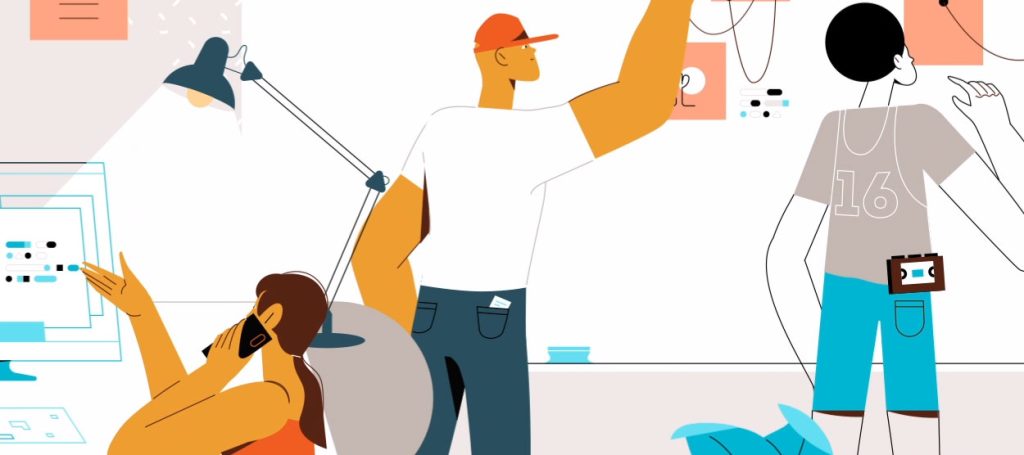In this article we identify the qualities of a good training video, with examples, and how to make engaging and effective training videos.

Training videos are one of the most essential components of an organization’s internal communications. How to make training videos that get results is no easy talk.
Traditional in-person training and printed training material can cost prohibitive for smaller business, and short attention spans are driving the need for video training. Creating training videos can be challenging, but there are a number of ways you can successfully incorporate video as part of your training and educational content.

At Creamy we’ve made hundreds of training videos for businesses in Canada, US, and around the world. Our animation studio’s 15+ years experience includes animated videos for business, explainer videos, corporate videos, training and educational videos.
We have worked with global brands governments and nonprofits. These include Responsible Gambling, YWCA Canada, Government of Canada, Fujitsu, Logitech, Canonical, Blockdaemon, Small Business BC, and other organizations across Canada.
Now that you know the foundational basics of creating great training videos, lets take look at some examples. Below are a few of the training video production projects we’ve worked on.
| VIDEO TYPE | PURPOSE | |
|---|---|---|
| 1. | Explainer & Educational Videos | Short, animated or live-action videos that simplify concepts. Great for onboarding, compliance, and product knowledge. |
| 2. | Scenario-Based Training Videos | Use real-world examples or dramatizations to show how to handle specific situations. Popular in customer service, healthcare, and safety training. |
| 3. | Demonstration / How-To Videos | Step-by-step walkthroughs of tasks, tools, or processes. Often used for software training, machinery use, or product tutorials. |
| 4. | Compliance & Policy Training Videos | Cover workplace rules, safety, legal requirements, or ethical guidelines. Often mandatory across industries. |
| 5. | Onboarding & HR Videos | Introduce new hires to company culture, values, and processes. Help employees get started quickly and consistently. |
Video platforms like YouTube, Twitter, Facebook, Instagram, LinkedIn and even TikTok and Snapchat have features that allow users to create, upload and share videos.
Training videos have become common and easier to create, once you have the right content. Explainer videos are one of the most effective ways to train your audience.
Training videos and videos created with the purpose of instructing or teaching people on a specific topic. This type of video can be in the form of passing information or skill, for example,
They are designed to provide the users or viewers with a complete picture. They make it easy to provide clear instructions on specific procedures. Creating training videos that utilize visuals makes it easier to explain and showcase products and services.
With increased global access to the internet, consumers are predicted to spend a daily average of 1.5 hours and 16 hours per week watching videos online.
It’s sure hard enough to understand a topic clearly using long written instructions with little visuals, but an instructional video will fix all that.

People process visuals faster and better, making videos the best media to impart knowledge and skills. In addition, viewers retain 95% of a message when they watch it in a video compared to 10% when reading it in text.
Videos for training is widel y used in education, corporations, healthcare, and entertainment. Creating training videos is beneficial in the following ways:
Here are s few examples of training videos based on the style. Animated training videos are a great alternative to live action because of their versatility.
You can demonstrate complex processes without picking up a camera and traveling to multiple locations.
On the other hand, live action videos allow you to show the human side of your business and record talking heads when there’s a need to show people.
Training videos are great tools for simplifying complex and abstract ideas into digestible understandable information. When you create training videos, its of the utmost importance to know the different types that exist so that you make the most suitable decision which helps you make great training videos.
A well-designed video on any landing page can increase the conversion rate by 80 percent.
There are many types of videos, and selecting the best type depends on the goals, audience or market needs, available resources (time and money), budget, and preferences. We will discuss a few of the types of video training available, namely:
This is the most popular training video type, that features an instructor speaking and delivering information on a screen to a virtual audience.
Instructors use slide decks, images, screencasts and examples in order to make the training video effective and engaging. The videos are concise, with experts recommending the videos be short—between six to ten minutes is the optimal length for a video, and the content is broken into several short videos for easy understanding.
How-to training videos show step-by-step instructions on how to do something. These types of videos are popular on YouTube, also -known as tutorials, and have subsequently led to the urban phrase “learning from The University of YouTube.”
This step-by-step process structure allows learners to have control of their learning (at their own time, pace and convenience) and to be fully engaged as it involves a learning-by-doing approach.
How-to videos effectively tackle multiple subjects from cooking to fixing complex electronics to data analysis and serve as a guide for learners along each step.
Popular for demonstrating technical processes like software tutorials and demos, screen share training videos help companies teach their customers how to use their software.
Screen share training videos, usually with voice-over narration from the product demonstrator, help guide learners on how to use the different features of the software.
Of all the videos, interactive training videos are one of the most effective for learning tools. This is because they actively require the involvement and engagement of learners with interactive features like quizzes and choosing a course of action based on scenarios and knowledge provided.
While costly in terms of budget and time to produce, interactive training videos provide an immersive learning experience and can be integrated into any video to increase learner engagement.
Animated videos are created and produced using animation styles like motion graphics, cartoons, icons, whiteboard, 2D/3D animation, and infographics, to mention but a few.
Animated videos are a favourite to use to explain complex and technical processes and ideas. They use visual animations to tell stories that learners find easy to connect with and remember.
Short training videos, or micro-training, are excellent tools for motivation, sharing best practices and knowledge refreshers for learners.
Its created by tapping into a learner’s prior knowledge, delivers content, recaps the information shared and shares the next steps to encourage knowledge retention and behavioural change.
Knowing your audience goes hand-in-hand with picking the right video towards producing great training videos. Without fully understanding your audience, you run the risk of producing a training video that holds no interest to the target audience.
For you to identify and know your audience, it’s paramount to collect essential demographic information on them like age, sex, skills, and location, among others, in order to understand their needs, pain points, habits and interests. This background information will not only help you identify your specific target audience, but it will also assist you in picking the right topic, idea, content and type of video to create.
In order to make great training videos, its vital to always put the audience first and thinking about their point of view.
After identifying and selecting your audience, choosing type of training video you want to create is the next step. The type of video depends on your goals and subject being covered.
Select the best corporate video style also taking into consideration how the video will be delivered. Some employee training videos need to be more interactive, while a children’s educational video can use basic animation to keep things fun and engaging.
Selecting an idea for a video topic is essential. Before you choose a topic idea, you should be clear about the purpose of creating the training video; for example, is it a tutorial or explainer or onboarding video, and what you would like your audience to know.
The training goal will then determine and narrow down the right topic idea for the training video so you know what type of content to develop and what information to include.

As a creator, you can envision what the video looks like and what features and scenes you would like to see included. However, bringing this vision to life requires preparation before recording the video. The prep work involves committing the ideas and scenes from your mind to paper to create a script and storyboard.
A video script is your blueprint for a winning video. A well-written script is an effective tool in ensuring that the training video contains the relevant information and is organized and easy to understand for learners.
The secret to writing a good script for training videos is concise information and remembering the audience’s perspective. The script language should be conversational and simple. Check out our article on how to write an explainer video script.
To write a script, you can begin with these basics:
With the script completed, next comes the storyboard. A storyboard is a visual flow representation of the video depicted by the use of pictures and sketches.
A storyboard takes the text written in the script and creates a simple visual equivalent that is arranged in chronological order based on the script flow. Creating a storyboard offers an overview of the information layout throughout the videos. The storyboard doesn’t need to be fancy; just a simple sketch will do to guide you to create the training video.
| AUDIO | VISUAL |
|---|---|
When dealing with an angry customer, it is important to acknowledge their frustration, ask questions to find out the problem and offer a possible solution. Customers want to know that they are being heard and that their problems are being resolved. | Split image of a customer care representative (nodding and listening) and angry customer (waving arms in frustration) |
| When buying used books from an online bookstore, take the time read their book condition guidelines to know the state in which the book is. | Click and show the book condition guideline page |

In order to create great training videos, good quality audio is essential.
It’s time to record and keep in mind that to make excellent videos, the video and audio must both be of high quality to make understanding seamless for the viewers. There are various visual and audio tools that can help you produce high-quality videos.
Invest in a decent external microphone. A good quality microphone will ensure audio clarity and high-quality sound. While you can use your computer’s inbuilt microphone, we don’t recommend it.
To produce good voice-over narrations, you need to:

Editing a video entails bringing together all the scenes created, designed and shot to create a cohesion and visually engagement which makes a great training video. In editing, you can use templates, backgrounds, music, videos, animation, and text overlays to enhance the video.
Editing a video requires the use of software that ranges from free to paid and from easy to advanced skill set. As a result, the process is time-consuming and intensive.
This leaves two options where you can learn how to use the software from YouTube tutorials and edit the video yourself or hire a good video editor to do it quickly and efficiently. Ultimately, the choice is what works best for you
Graphics and text are essential in a video for highlighting essential pieces of information that learners should pay attention to.
The use of text should be limited, and you should only use relevant graphics to illustrate the context of the information. For screen share recordings, annotations like arrows and boxes are used to show this important information.
Good video editing must have consistency with transitions, logos, fonts, colors and format. A consistent look and feel help create a cohesive flow within the video, making comprehension easier.

The video is ready to launch. We recommend that you save the video in MP4 format, as it’s a commonly used format and can play on most platforms.
However, you can also check the hosting platform’s accepted video format. There is a wide range of video hosting platforms, with the more popular being YouTube (for the public) and Vimeo (for private sharing). Training videos can also be hosted on company websites or a Learning Management System (LMS), depending on the use intention.
Screenshare recordings are the way to go for software demos. It allows you to show a step-by-step process on how to use the software app or platform.
To create a sound screen share recording, you need to:
Animated training videos are great for storytelling and professional animators like Creamy Explainers who deliver the information with simplicity and clarity.
When you create live action videos it’s important to higher a good camera or production studio with the necessary equipment and skills.
The latest smart phone can easily create good quality picture, if there’s good lighting. Getting it done right the first time will save you both time and money in the long haul.
For everyone involved in the shoot, a scheduled date, time and location must be arranged and agreed upon to secure everyone’s availability. In addition, everyone should know their roles, the video objective and the sequence of events so as to maximize the shooting time.
The ideal light would be good natural light, but as we know, the weather can change, affecting the look of the video quality. Therefore in order to have an evenly lit set, it’s preferable to use artificial lights that can be controlled as needed and provide consistent light.
The environment where the video is shot can make or break its quality. The best space would be one with limited vehicle or human traffic or sound with a simple background against which the presenter can sit so we can keep the focus on them.
A professional training video shoot needs equipment like tripods and gimbals for steady video shots, which improves the video’s production quality. Tripods are also excellent tools to use when filming yourself and have no one to assist.
Use the rule of thirds to position the video subjects in the left or right third of an image, leaving the other two-thirds more open. While there are other forms of composition, the rule of thirds generally leads to compelling and well-composed shots.
So what does it take to make great training videos? Its takes knowing your audience and identifying the best topic idea and the right video format. It’s essential that you create videos that are short, engaging, and easy to understand for learners.
Invest in a production company like Creamy for best results. We’re your perfect partner with the experience and skills to deliver high quality training content for your business.